Are you sometimes puzzled about the best fret-hand fingerings to use in a new song?
Well, you are not alone.
Many guitarists find it difficult to determine the best and correct fingerings for songs. Today we will demystify the basics of fret-hand fingerings so you can answer the question:
“Which finger goes where?”
The Basics of Fret-Hand Positions
The typical guitar has six strings and 19 or more frets. We generally only use four fingers of our fret-hand to play notes. So obviously, to cover the entire fretboard, we have to move our hand up or down the neck. Depending on the song, there may be many position shifts, or none at all.
The fingering rules we will cover today are for riffs, guitar solos, melody lines and scales, but not chords.
Here’s how it works…
Your fret-hand fingers are numbered from 1-4 (index to pinky).
Fret-hand positioning is based on the principle of assigning one finger per fret. So this means that if you position your fret-hand so that the first finger is on the first fret, the following will happen…
Your first finger will play any notes on the first fret. Your second finger will play any note that falls on the second fret. Your third finger will handle all of the notes on the third fret, and finally, your fourth finger will play the notes on the fourth fret.
Now if you move your first finger up to the fifth fret, here is what will happen…
Your first finger will play the notes on the fifth fret. Your second finger will play notes on the sixth fret. Your third finger will play the notes on the seventh fret. And your fourth finger will play all notes on the eighth fret.
If you move your first finger up to the sixth fret, it means…
Your first finger will play notes on the sixth fret. Your second finger will handle notes on the seventh fret. Your third finger will play notes on the eighth fret. And your fourth finger will play notes on the ninth fret.
Fret-Hand Position is Determined by the First Finger
The first finger establishes the position you are in. This means when the first finger is placed on the first fret, you are in first position. If you place one finger per fret starting on the ninth fret, you are in ninth position. If you place your fingers one per fret so that your first finger is on the third fret…you are in third position.
Okay so that’s pretty straight forward, but there is a problem—most songs don’t fall under this one finger per fret system from beginning to end.
What you will often find is some outlying notes. This means you will see some passages that have some notes that lie just a fret above or below the others. Instead of doing a position shift and having to rapidly switch back and forth between positions, an expanded fingering is used.
In the expanded fingering the first finger or fourth finger is given double duty. In this case, the first or fourth finger will handle the notes found on two adjacent frets. This means that the finger given double duty will have to stretch to cover the notes on two frets.
So for example, place your fingers one per fret starting on the seventh fret. This means your first finger will play the notes on the seventh fret, your second finger will play notes on the eighth fret, your third finger will play notes on the ninth fret, and your fourth finger will play notes on the tenth fret.
If your first finger is given double duty, it means that it will also play the notes on the sixth fret.
If the first finger is given double duty, we determine the fret-hand position based upon where it lies when not stretched. In other words, the two above diagrams are both in seventh position.
If your fourth finger has double duty, it means it will cover the notes on the tenth and eleventh frets.
The above fingering is also in seventh position.
Occasionally you will encounter songs or scales were both your first and fourth fingers will need to stretch—a sort of double-double duty!
If notes lie beyond this, you will need to use additional fret-hand positions.
Now you can see why most songs use many different fingerings and multiple fret-hand positions.
So how do you know what fingering positions are used in a song? This is where your knowledge of guitar scales comes into play. When you know your guitar scales and understand how they link with each other over the entire fretboard, you will find it quite easy to determine fingerings for songs. When you can “see” these fingerings on the guitar neck, you will almost instinctively know the best fret-hand fingerings to use.
To discover how to master guitar scales and see how they connect with each other, check out The World of Scales: A Compendium of Scales for the Modern Guitar Player.

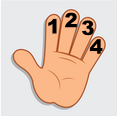

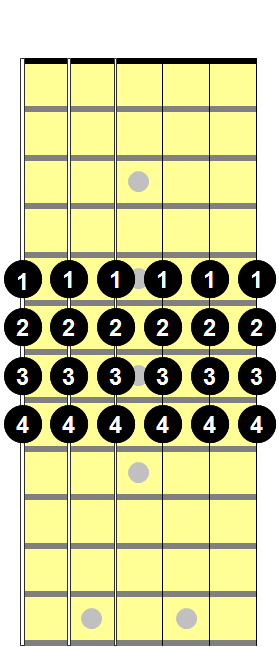
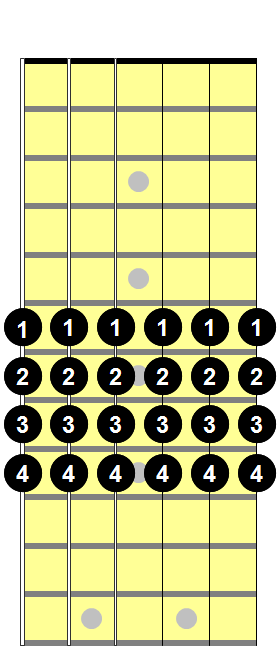
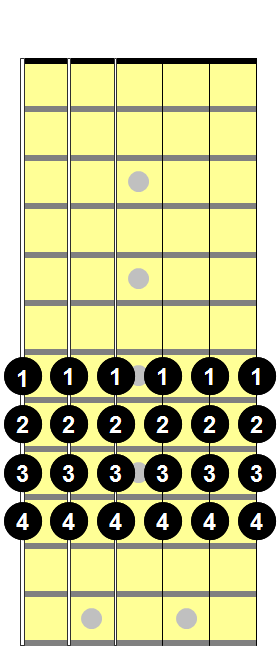
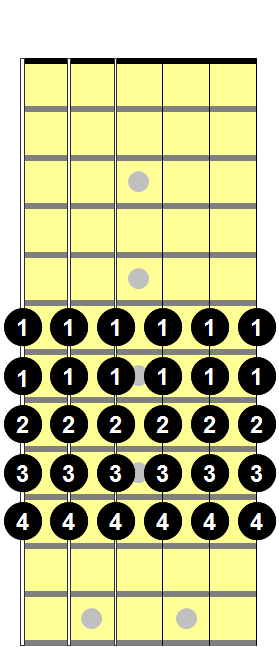
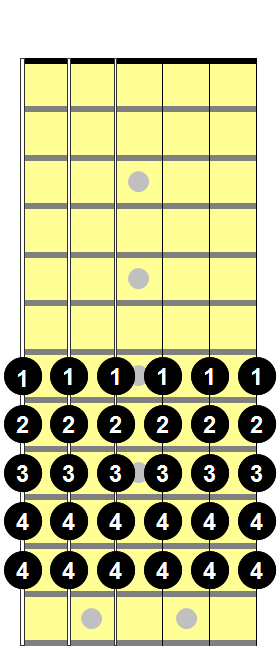





Pingback: Guitar Accelerator Song of the Month: Wohlfahrt Study #19 Arranged for Intermediate Guitar | Guitar Accelerator Blog: Play Guitar - Over 100 Free Electric and Acoustic Guitar Lessons and Tutorials